History
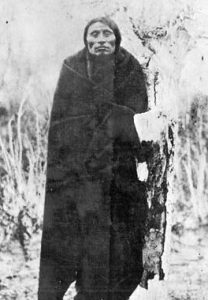 Little Wolf was a Cheyenne Indian who was often called “the greatest of the fighting Cheyenne.” Little Wolf was the chief of an elite Cheyenne military society called the Bowstring Soldiers. Little Wolf had demonstrated a rare form of bravery and a brilliant understanding of battle tactics from a very early age, which led to him becoming a trusted leader. His prowess showed first in conflicts with other Indians like the Kiowa, but even more in disputes with the United States Army, Little Wolf led or assisted in dozens of important Cheyenne victories.
Little Wolf was a Cheyenne Indian who was often called “the greatest of the fighting Cheyenne.” Little Wolf was the chief of an elite Cheyenne military society called the Bowstring Soldiers. Little Wolf had demonstrated a rare form of bravery and a brilliant understanding of battle tactics from a very early age, which led to him becoming a trusted leader. His prowess showed first in conflicts with other Indians like the Kiowa, but even more in disputes with the United States Army, Little Wolf led or assisted in dozens of important Cheyenne victories.
While it has not been confirmed, most historians agree that Little Wolf was probably involved in the disastrous Fetterman Massacre of 1866. In that battle, the Cheyenne lured the 80 American soldiers out of the fort in Wyoming, and wiped them out. Cheyenne attacks also forced the United States military to abandon Fort Phil Kearney along the Bozeman Trail, and Little Wolf is believed to have led the war party in torching of the fort. He was also a leading participant in the greatest of the Plains Indian victories, the Battle of the Little Bighorn in 1876.
Even with such an impressive list of victories to his credit, Little Wolf, like many of the other Plains Indian warriors, was finally forced to make peace with the White Man. After the horrendous loss at the Battle of the Little Bighorn, the army launched a major offensive. In 1877, the government sent Little Wolf to a reservation in Indian Territory. Little Wolf was disgusted with the conditions and the lack of supplies the Indians were forced to endure. In 1878 Little Wolf made up His mind to leave the reservation. His plan was to head north for the old Cheyenne territory in Wyoming and Montana. Chief Dull Knife and 300 of his followers went with him.
Little Wolf and Dull Knife made it clear that their intentions were peaceful, but the settlers in the territory we’re afraid they would attack. So, once again, the government sent cavalry forces that assaulted the Indians. Little Wolf’s skillful defensive maneuvers kept Cheyenne casualties low. When the band neared Fort Robinson, Nebraska, Dull Knife and some of his followers stopped there, but Little Wolf and the rest of the Cheyenne continued to march north to Montana.
In the spring of 1879, while still traveling north, Little Wolf and his followers were overtaken by a cavalry force 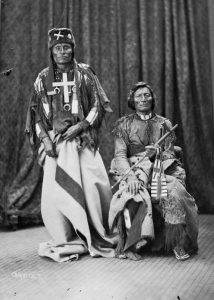 under the leadership of Captain W.P. Clark, who happened to be an old friend of Little Wolf’s. The confrontation could have easily turned violent, but with his force of warriors diminished and his people tired, Little Wolf was reluctant to fight the more powerful American army. Clark’s civilized and gracious treatment of Little Wolf helped convince the chief that further resistance was pointless, and he agreed to surrender.
under the leadership of Captain W.P. Clark, who happened to be an old friend of Little Wolf’s. The confrontation could have easily turned violent, but with his force of warriors diminished and his people tired, Little Wolf was reluctant to fight the more powerful American army. Clark’s civilized and gracious treatment of Little Wolf helped convince the chief that further resistance was pointless, and he agreed to surrender.
After returning to the reservation, Little Wolf briefly served as a scout for General Nelson A. Miles. However, during this time he disgraced himself among his people by killing one of his tribesmen. The formerly celebrated Cheyenne warrior lived out the rest of his life on the reservation but had no official influence among his own people. After all of his honorable leadership and years of respect among his peers, Little Wolf was, in the end, taken down by his one dishonorable act. People always remember the things you do wrong, but the things you do right seem to fade quickly away.
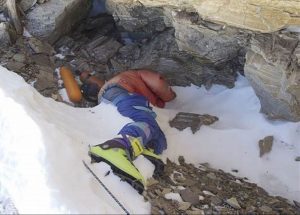 I love to hike, but that does not include going to the highest peak I can find. Don’t get me wrong, because I have hiked to the top of some mountains. They just weren’t on the level of Everest or K2. While I love to challenge myself by hiking up some pretty big mountains, I’m just not interested in taking on the ones where the air is so thin that you need oxygen, and the snow never melts. There are, nevertheless, people who feel the challenge to ascend to the highest peaks in the world. They throw caution to the wind, to go where few people have ever gone before. Believe me, I admire their tenacity, but that is simply not a goal I have, or ever will set, for myself.
I love to hike, but that does not include going to the highest peak I can find. Don’t get me wrong, because I have hiked to the top of some mountains. They just weren’t on the level of Everest or K2. While I love to challenge myself by hiking up some pretty big mountains, I’m just not interested in taking on the ones where the air is so thin that you need oxygen, and the snow never melts. There are, nevertheless, people who feel the challenge to ascend to the highest peaks in the world. They throw caution to the wind, to go where few people have ever gone before. Believe me, I admire their tenacity, but that is simply not a goal I have, or ever will set, for myself.
Mount Everest is a very unforgiving mountain. In the years that people have been climbing it, there have been over 200 deaths on it slopes. These were experienced climbers who knew what they were up against, and yet, the elements and the lack of breathable oxygen, beat them in the end. Of those 200+ people who lost their lives to Everest, many are still up on the slopes, right where they fell. They didn’t get off the beaten paths, they just didn’t get back down quickly enough, and now their bodies serve as a grim reminder of the harsh reality that is Everest. These people might have truly believed that they could make it, and many of them had no idea that they were dying. Severe cold and lack of oxygen will do that to a person.
In a gruesome ritual, each new climber who takes the challenge and starts up the mountain, must pass by the unfortunate ones who didn’t make it back down. To me, the bodies would serve as a warning to turn around and go back down, now…to use my head and stay alive, rather than my ambition to succeed at something that, to most of us, seems insane. I know that there are people who would disagree, believing that challenge is worth the risk, and it might be, right up to the point when you realize that you are about to become a statistic of Mount Everest. Of course, by the time you realize that, it is too late.
Mount Everest, located some 186 miles north-east of Kathmandu, holds the impressive title of tallest mountain in the world, but many people don’t know about its other, more gruesome title…the world’s largest open-air graveyard. Edmund Hillary and Tenzing Norgay first scaled the summit in 1953. Since then, over 4,000 people have followed in their footsteps, braving the harsh climate and dangerous terrain in the hope of a few moments of glory. Unfortunately, some of them never left the mountain. The top portion of the mountain, roughly everything above 26,000 feet, is known as the “death zone.” In the “death zone” the oxygen levels are only at a third of what they are at sea level, and the barometric pressure causes weight to feel ten times heavier. The combination of those two factors makes climbers feel sluggish, disoriented and fatigued…and can cause extreme stress on organs. For this reason, climbers don’t usually last more than 48 hours in this area.
The climbers that overstay their safety window are usually left with lasting effects. The ones that don’t make it out are left where they fall…it’s standard protocol, unfortunately, and so these corpses remain to spend eternity on the mountaintop, serving as a warning to climbers as well as gruesome mile markers. Each climber who attempts Mount Everest knows the possibilities. One of the most famous corpses, known as “Green Boots” was passed by almost every climber to reach the death zone. The identity of Green Boots while highly contested, is believed to be Tsewang Paljor, an Indian climber who died in 1996. Before the body’s recent removal, Green Boot’s body rested near a cave that all climbers must pass on their way to the peak. The body became a grim landmark used to gauge how close one is to the summit. He is famous for his green boots. According to one seasoned adventurer “about 80% of people also take a rest at the shelter where Green Boots is, and it’s hard 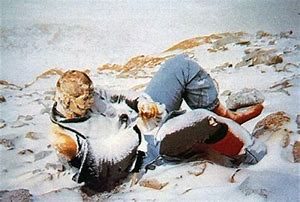 to miss the person lying there.” “Green Boots” is known as such because of the neon boots he was wearing when he died.
to miss the person lying there.” “Green Boots” is known as such because of the neon boots he was wearing when he died.
In 2006 another climber joined in Green Boots in his cave, sitting, arms around his knees in the corner, forever. David Sharp was attempting to summit Everest on his own, which is never advisable. Even the most advanced climbers would warn against it. He had stopped to rest in Green Boots’ cave, as so many had done before him. Over the course of several hours, he froze to death, his body stuck in a huddled position, just feet from one of the most famous Mount Everest bodies. Green Boots most likely died unnoticed, due to the small amount of people hiking at that time, but at least 40 people passed by Sharp that day. Incredibly, not one of them stopped. Sharpe’s death sparked a moral debate about the culture of Everest climbers. Though many had passed by Sharp as he lay dying, and their eyewitness accounts claim he was visibly alive and in distress, no one offered their help. How could they even live with themselves after that?
Sir Edmund Hillary, the first man to ever summit the mountain, criticized the climbers who had passed by Sharp and attributed it to the mind-numbing desire to reach the top. “If you have someone who is in great need and you are still strong and energetic, then you have a duty, really, to give all you can to get the man down and getting to the summit becomes very secondary,” he told the New Zealand Herald, after news of Sharp’s death broke. “I think the whole attitude towards climbing Mount Everest has become rather horrifying,” he added. “The people just want to get to the top. They don’t give a damn for anybody else who may be in distress and it doesn’t impress me at all that they leave someone lying under a rock to die.” The media termed this phenomenon “summit fever,” and it’s happened more times than most people realize.
In 1999, the oldest known body was found on Everest. George Mallory’s body was found 75 years after his 1924 death after an unusually warm spring. Mallory had attempted to be the first person to climb Everest, though he had disappeared before it could be found out if he had achieved his goal.
His body was found in 1999, his upper torso, half of his legs, and his left arm almost perfectly preserved. He was dressed in a tweed suit and surrounded by primitive climbing equipment and heavy oxygen bottles. He had a rope injury around his waist, which led those who found him to believe he had been roped to another climber when he fell from the side of a cliff. The fate of the other climber is unknown, and no one knows if Mallory made it to the top, so the title of “the first man to climb Everest” was given to someone else. Though he may not have made it, rumors of Mallory’s climb had swirled for years, leading many to wonder. He was a famous mountaineer at the time and when asked why he wanted to climb the then unconquered mountain, he famously replied, “Because it’s there.”
One of the most horrifying sights on Mount Everest is the body of Hannelore Schmatz. In 1979, Schmatz became not only the first German citizen to perish on the mountain but also the first woman. Schmatz had actually reached her goal of summiting the mountain, before ultimately succumbing to exhaustion on the way down. Her Sherpa’s warned her not to set up camp in the “death zone,” but she did anyway. She managed to survive a snowstorm hitting overnight, and made it almost the rest of the way down to camp before a lack of oxygen and frostbite resulted in her giving into exhaustion. This poor woman fell just 330 feet from base camp. That is a devastating loss…so close and yet too far. Her body remains on the mountain, extremely well preserved due to the consistently below zero temperatures. For a long time, her body remained in plain view of the mountain’s Southern Route, leaning against a long deteriorated backpack with her eyes open and her hair blowing in the wind. Then, 70-80 mph winds either blew a covering of snow over her or pushed her off the mountain. Her final resting place is currently unknown.
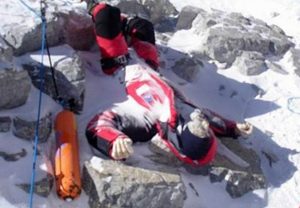 It’s due to the same things that kill these climbers that recovery of their bodies can’t take place. To us that seems insane, but when someone dies on Everest, especially in the death zone, it is almost impossible to retrieve the body. The weather conditions, the terrain, and the lack of oxygen makes it difficult to get to the bodies. Even if they can be found, they are usually stuck to the ground, frozen in place. In fact, two rescuers died while trying to recover Schmatz’s body and countless others have perished while trying to reach the rest. Despite those risks, and the bodies they know they will encounter, thousands of people still flock to Everest every year to attempt one of the most impressive, if not insane, feats known to man today.
It’s due to the same things that kill these climbers that recovery of their bodies can’t take place. To us that seems insane, but when someone dies on Everest, especially in the death zone, it is almost impossible to retrieve the body. The weather conditions, the terrain, and the lack of oxygen makes it difficult to get to the bodies. Even if they can be found, they are usually stuck to the ground, frozen in place. In fact, two rescuers died while trying to recover Schmatz’s body and countless others have perished while trying to reach the rest. Despite those risks, and the bodies they know they will encounter, thousands of people still flock to Everest every year to attempt one of the most impressive, if not insane, feats known to man today.
 Living in Wyoming, the one thing we can be sure of is that traffic jams are extremely uncommon here. About the only way we are going to have a traffic jam is if there is an accident at what we call rush hour…for lack of a better word. A few hours south of us, you mike find a traffic jam as you travel through Denver, Colorado during a real rush hour. Nevertheless, even traffic jams in Denver almost don’t qualify compared to other places on Earth. I have tried to think of what it might be like to be in a really bad traffic jam. I have been in some that kept me sitting for over an hour, but even that was nothing compared to the longest traffic jam in history.
Living in Wyoming, the one thing we can be sure of is that traffic jams are extremely uncommon here. About the only way we are going to have a traffic jam is if there is an accident at what we call rush hour…for lack of a better word. A few hours south of us, you mike find a traffic jam as you travel through Denver, Colorado during a real rush hour. Nevertheless, even traffic jams in Denver almost don’t qualify compared to other places on Earth. I have tried to think of what it might be like to be in a really bad traffic jam. I have been in some that kept me sitting for over an hour, but even that was nothing compared to the longest traffic jam in history.
China is one of the biggest automotive markets in the world. That booming market has a downside to it too, however. It is estimated, that in 2015, there were no less than 7 million cars on the road in Beijing. Of course there are many more now. What’s more, nearly 14 million cars are purchased each year, while 650,000 vehicles meet the road every month. It’s like saying: “Hey, everybody in Beijing must have a car. No, make that two!.” The government has tried to stop residents from buying so many cars, but they haven’t had much luck with that. With all the cars on the road, traffic jams were inevitable. Nevertheless, I don’t think anyone could have predicted just how bad those traffic jams would become. In August 2010, China was crowned the unofficial “host” of the mother of all traffic jams, with a huge car panorama that stretched for more than 62 miles and lasted for 12 days. I’m quite certain that no one could have expected this, now could the motorists be prepared with food and water.
It all happened on the Beijing-Tibet Expressway near Beijing. The highway was initially designed to be used exclusively by trucks, but due to the growing number of vehicles, passenger cars started using it too. Ironically, the cause of the huge traffic jam was the road work on the highway. Trucks carrying construction supplies to Beijing, most of them supposed to be used on the expressway in order to ease traffic, were blocked at the exit, thus causing a traffic jam that lasted over 12 days. No clear statistics concerning the number of stranded drivers were given, but instead reports published on the web at that time claim that some of the cars advanced with a speed of 2 miles per day! That is shockingly slow!!
People who could started to take advantage of the situation by selling food and water to drivers. The prices were extremely high and some of the drivers even refused to buy the supplies. That was not a good idea, because in those cases they were robbed or even stabbed. Twelve days in a traffic jam is a lot, that’s pretty  clear, and even if some drivers already had bread and cigarettes as a method of precaution, everybody had to buy at least a cup of water. The prices were astronomical, and the whole situation was insane. Strangely, authorities actually expected the traffic jam to last about a month. I guess 12 days wasn’t too bad after all. Surprisingly, according to the Guinness World of Records this isn’t the longest traffic jam in history. A previous episode that took place in France, spanning from Lyon to Paris, is regarded as the biggest jam ever. It stretched for 109 miles and happened on February 16, 1980. The reason, poor weather and the huge number of cars on the French Autoroute.
clear, and even if some drivers already had bread and cigarettes as a method of precaution, everybody had to buy at least a cup of water. The prices were astronomical, and the whole situation was insane. Strangely, authorities actually expected the traffic jam to last about a month. I guess 12 days wasn’t too bad after all. Surprisingly, according to the Guinness World of Records this isn’t the longest traffic jam in history. A previous episode that took place in France, spanning from Lyon to Paris, is regarded as the biggest jam ever. It stretched for 109 miles and happened on February 16, 1980. The reason, poor weather and the huge number of cars on the French Autoroute.
 Many people have gone on a journey to find themselves. I used to think that those were mostly the Hippies, but the reality is that while most of us don’t necessarily go anywhere, we are on a mind journey to find ourselves, because for whatever reason we aren’t happy with where we are, or our situation has changed, and now we need to re-define ourselves.
Many people have gone on a journey to find themselves. I used to think that those were mostly the Hippies, but the reality is that while most of us don’t necessarily go anywhere, we are on a mind journey to find ourselves, because for whatever reason we aren’t happy with where we are, or our situation has changed, and now we need to re-define ourselves.
One woman went on a visit to Iceland in 2012, and somehow managed to put a totally new spin on the idea of finding herself. The woman, decided to take a tour of Iceland’s southern volcanic region. The tour was going well, and everyone was having a great time. After a stop, the tour company driver counted all the passengers on the tour, and found that one woman was missing. The tour driver waited for an hour for the woman to return, assuming that she was just a little delayed or lost track of time at the stop. Finally, he had no choice but to report her missing to the police.

The missing woman was in Iceland’s southern volcanic region near the island’s Eidgja canyon, a remote but popular walking area for visiting tourists. The police set up search teams, which were dispatched to the area. They started combing the barren treeless hillsides looking for an Asian woman described as 5 foot 2 inches tall, and wearing dark clothing. The teams searched the area until 3am, when the search was finally called off. Oddly, it wasn’t called off because there was no hope of finding her, but because she was located…and, in the most bizarre way.
It turns out that the woman wasn’t missing after all. She had decided to freshen up a bit, and in the process, she changed her clothes. The people on the tour somehow didn’t recognize her with the different clothing, and since the woman’s name was not given, but rather, just a description of her, the woman had no idea that she had joined the search teams…in search of herself!! The minute it occurred to her that they were searching for  her, she quickly informed the police that she was the woman who was the subject of their search.
her, she quickly informed the police that she was the woman who was the subject of their search.
Sveinn Runarsson, the police chief in charge of the rescue, commented that “the people on the bus had not been counted correctly”. What a bizarre turn of events. Thankfully the woman was found, but the whole scenario would be quite hilarious, had everyone not been so concerned for her safety. I guess the moral of the story would be that in these situations, it might be a good idea to say the name of the subject of the search, so that if they happen to be there, they can tell you not to bother.
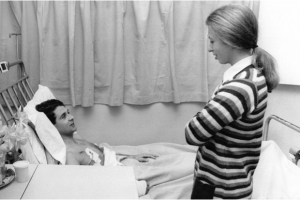
 For people of notoriety, the possibility of a kidnap attempt exists. That possibility became very real to Great Britain’s Princess Anne and her husband, Captain Mark Phillips on March 20, 1974, as they were returning to Buckingham Palace. It was the closest that anyone has come to abducting a member of the British Royal family in modern times.
For people of notoriety, the possibility of a kidnap attempt exists. That possibility became very real to Great Britain’s Princess Anne and her husband, Captain Mark Phillips on March 20, 1974, as they were returning to Buckingham Palace. It was the closest that anyone has come to abducting a member of the British Royal family in modern times.
Princess Anne was just 23 years old at the time. She was a fun-loving royal celebrity of the day. She was a skilled equestrian, who had been named BBC Sports Personality of the Year in 1971, but it was her marriage to a commoner, Captain Mark Phillips that caused a sensation. It is estimated that 500 million watched the ceremony on television. It was a bit unusual for royalty to marry commoners, but as we know, it does happen.
Princess Anne has long been one of the hardest working royals, and still is to this day. On the night of the attempted kidnapping, the couple were returning to Buckingham Palace after a charity film screening. At about 8pm, their chauffeur-driven Rolls Royce was making its way along the Mall when a white Ford Escort suddenly pulled in front and blocked the road. The driver, who was later identified as 26 year old Ian Ball, who was an unemployed laborer suffering from mental illness, jumped out, waving two handguns.
Thankfully, Anne’s bodyguard, Inspector James Beaton, and chauffeur Alex Callendar went to disarm him. Both were shot, but miraculously not fatally. A passing tabloid journalist was also shot. Beaton, who got back to his feet and was shot three times during the attack, was later awarded the George Cross. Ball got into the limo and demanded Anne get out, to which she retorted, “Not bloody likely!” Those were bold words for a young woman facing a would be captor. Obviously, Princess Anne was no ordinary young woman.
Into the chaotic scene ran former boxer Ron Russell, who punched Ball in the head and led the Princess to 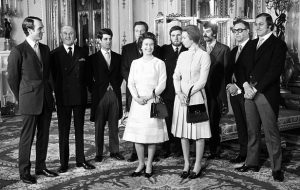
 safety as police arrived. Police officer Michael Hills was also shot before Ball was finally tackled to the ground. The assailant was sentenced to life imprisonment and placed in a psychiatric hospital. In Ball’s car, police found handcuffs, tranquillizers and a ransom note addressed to the Queen. In the letter, he demanded that £2 million be paid to the National Health Service. After Anne’s miraculous escape, the royal family’s security was increased to ensure something like that could never happen again.
safety as police arrived. Police officer Michael Hills was also shot before Ball was finally tackled to the ground. The assailant was sentenced to life imprisonment and placed in a psychiatric hospital. In Ball’s car, police found handcuffs, tranquillizers and a ransom note addressed to the Queen. In the letter, he demanded that £2 million be paid to the National Health Service. After Anne’s miraculous escape, the royal family’s security was increased to ensure something like that could never happen again.
 These days, the weather centers can predict storms weeks out. True, they aren’t always as accurate as we would like, but they can also predict corrections and update people with the changes. Of course, it is something we are used to in this day and age, but in 1941, weather centers didn’t exist. That was catastrophic for the people of North Dakota and Minnesota, when a fast-moving and quite severe blizzard hit on March 15th, killing 151 people. The storm came in so quickly that the people had no warning, and as a result far too many lost their lives.
These days, the weather centers can predict storms weeks out. True, they aren’t always as accurate as we would like, but they can also predict corrections and update people with the changes. Of course, it is something we are used to in this day and age, but in 1941, weather centers didn’t exist. That was catastrophic for the people of North Dakota and Minnesota, when a fast-moving and quite severe blizzard hit on March 15th, killing 151 people. The storm came in so quickly that the people had no warning, and as a result far too many lost their lives.
Because of that storm, weather forecasting and reporting systems made important advances that would have prevented the loss of life that occurred due to the sudden storm. The people of North Dakota and northern Minnesota had virtually no warning of the blizzard that was coming, until it swept in suddenly from the west on March 15. In some locations, temperatures dropped 20 degrees in less than 15 minutes. They were hit with 55 mile per hour sustained winds, and gusts reaching 85 miles per hour in Grand Forks and 75 miles per hour in Duluth. The winds 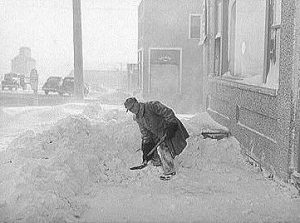 brought blinding snow and huge 7 foot high snow drifts across the states. Most of the victims of the blizzard were traveling in their cars when it hit. Highway 2, running from Duluth, Minnesota to North Dakota, was shut down, as were Highways 75 and 81. Attempts to rescue those stranded in their cars came too late. In one incident, six year old Wilbert Treichel died from exposure to the cold when his parents abandoned their car and attempted to carry him through the blizzard to safety.
brought blinding snow and huge 7 foot high snow drifts across the states. Most of the victims of the blizzard were traveling in their cars when it hit. Highway 2, running from Duluth, Minnesota to North Dakota, was shut down, as were Highways 75 and 81. Attempts to rescue those stranded in their cars came too late. In one incident, six year old Wilbert Treichel died from exposure to the cold when his parents abandoned their car and attempted to carry him through the blizzard to safety.
People attending a basketball game in Moorhead, Minnesota, were stranded at the arena overnight when it was wisely decided that travel was too dangerous for the 2,000 people. Theaters, hotels and stores across the region stayed open through the night to accommodate the many people had visited them, completely unaware that a major storm was approaching. Although the storm was also severe in Manitoba, Canada, only seven people there died because the population was much better prepared for the storm and for dangerous weather in general.
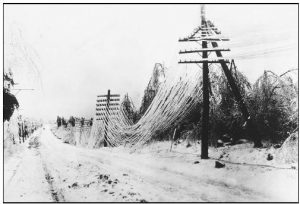
Prior to this time, meteorologists in Chicago were concerned mostly with local weather. It wasn’t that they did not care about the people in surrounding areas, but rather that it was not traditional reporting to report weather for the other areas. In the aftermath of this blizzard, weathermen in North Dakota and Minnesota, who had been under the control of the Chicago meteorology office, which simply paid less attention to events occurring to the north, were allowed autonomy in their reporting. Protected with new technological advances in the wake of the disaster, area residents hoped they would never again be so blind-sided by a winter storm.

 Saint Patrick’s Day…a day to celebrate being Irish. For me, Saint Patrick’s Day always felt like a borrowed holiday…probably because I don’t live in Ireland. The reality is that while I don’t live in Ireland, I am part Irish…9% to be exact. With the Irish in my family history, I would have expected my percentage to be for that 9%, but the reality is that most families migrated around the world, and while a family might have been in a country for centuries, they may not have originated there. Nevertheless, I had and still have family who live in Ireland, so I guess that makes me enough Irish to make Saint Patrick’s Day as much my day as it is anyone else’s. In reality, it is a day to remember the patron saint of Ireland. Saint Patrick was a missionary who heralded the shift from paganism to Christianity in the fifth century, when he was in his 40s. Saint Patrick’s Day is celebrated on what is believed to be the anniversary of his death…March 17.
Saint Patrick’s Day…a day to celebrate being Irish. For me, Saint Patrick’s Day always felt like a borrowed holiday…probably because I don’t live in Ireland. The reality is that while I don’t live in Ireland, I am part Irish…9% to be exact. With the Irish in my family history, I would have expected my percentage to be for that 9%, but the reality is that most families migrated around the world, and while a family might have been in a country for centuries, they may not have originated there. Nevertheless, I had and still have family who live in Ireland, so I guess that makes me enough Irish to make Saint Patrick’s Day as much my day as it is anyone else’s. In reality, it is a day to remember the patron saint of Ireland. Saint Patrick was a missionary who heralded the shift from paganism to Christianity in the fifth century, when he was in his 40s. Saint Patrick’s Day is celebrated on what is believed to be the anniversary of his death…March 17.
It is traditional to wear green on Saint Patrick’s Day, but why is that? Legend has it that if you’re wearing the color green, the quintessentially Irish, fairy-like creatures called leprechauns won’t be able to see you. And if they can’t see you, they can’t pinch you. Interestingly, before Saint Patrick’s Day got started, leprechauns were known not for wearing green but red. These days, the leprechauns have begun to outsource pinching to the rest of the world, or maybe we just took it over. Even the Irish flag has green in it. It is deeply symbolic. The green represents the Irish Catholics, the orange represents the Protestants and the white represents peace between the two. The green itself is called “shamrock green.” And speaking of shamrocks, shamrocks are one of the national symbols of Ireland, and not without reason. St. Patrick himself used the green, three-leaf clover to teach the Irish about the Holy Trinity: one for the father; one for the son; and one for the Holy Spirit. The four-leaf clover is just a symbol of good luck, if you believe in luck. Personally, I prefer blessing over luck.

 When a large population of the Irish came to the United States in the mid-1800s, they wore the color green (as well as the Irish flag) as a point of national pride, further solidifying the relationship between the color green and the Irish…in the American imagination anyway. But lets face it, it’s really about the kid in all of us. Celebrating Saint Patrick’s Day with pinches and shamrock accessories might seem silly, but it can be a great way to spend a day being a little bit on the goofy side. Friendly pinches of those who are forgetful, and show up with no green, is a great way to spend that one day…often still cold and even snowy, having a little bit of silly fun. And then there is the green beer, the green Chicago river, and the green clothing, hair, and beards of our friends.
When a large population of the Irish came to the United States in the mid-1800s, they wore the color green (as well as the Irish flag) as a point of national pride, further solidifying the relationship between the color green and the Irish…in the American imagination anyway. But lets face it, it’s really about the kid in all of us. Celebrating Saint Patrick’s Day with pinches and shamrock accessories might seem silly, but it can be a great way to spend a day being a little bit on the goofy side. Friendly pinches of those who are forgetful, and show up with no green, is a great way to spend that one day…often still cold and even snowy, having a little bit of silly fun. And then there is the green beer, the green Chicago river, and the green clothing, hair, and beards of our friends.
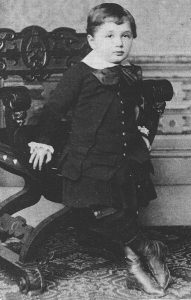
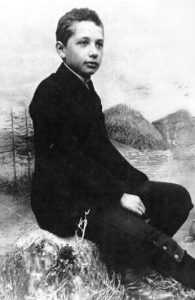 When I think of a genius, my favorite genius always comes to mind…Albert Einstein. He doesn’t have the highest recorded IQ in history, and in fact, is listed as 12th among geniuses. Nevertheless, Genius Day…a day to highlight the greatest minds out there, falls on Albert Einstein’s birthday, so maybe he is a favorite of a lot of people. It makes sense, because Albert Einstein is on of the most famous, iconic, influential, and admired people in history. He was incredibly smart, but oddly not snobby about it, like some geniuses, who rub me the wrong way.
When I think of a genius, my favorite genius always comes to mind…Albert Einstein. He doesn’t have the highest recorded IQ in history, and in fact, is listed as 12th among geniuses. Nevertheless, Genius Day…a day to highlight the greatest minds out there, falls on Albert Einstein’s birthday, so maybe he is a favorite of a lot of people. It makes sense, because Albert Einstein is on of the most famous, iconic, influential, and admired people in history. He was incredibly smart, but oddly not snobby about it, like some geniuses, who rub me the wrong way.
I wonder what it must have been like to be a genius in a day when the system didn’t necessarily recognize such things. Einstein started school, as most children did, in a normal Catholic elementary school, in Munich, Germany, and remained there for 3 years. At that point, they realized that they didn’t have the ability to teach such a child. He was transferred to he Luitpold Gymnasium (now known as the Albert Einstein Gymnasium) at age 8, where he received advanced primary and secondary school education until he left the German Empire seven years later. In German, gymnasium means high school. Einstein excelled at math and physics right from the start. He reached a mathematical level years ahead of his peers. At twelve years old, Einstein taught himself algebra and Euclidean geometry in one summer. Einstein also independently discovered his own original proof of the Pythagorean theorem at age 12. Those were years of intense discovery for him…discoveries that most people could never begin to fathom. At age 13, Einstein was introduced to Kant’s Critique of Pure Reason, and Kant became his favorite philosopher, his tutor stating: “At the time he was still a child, only thirteen years old, yet Kant’s works, incomprehensible to ordinary mortals, seemed to be clear to him.” Probably his best known work was the Theory of Relativity, which actually took in two theories by Albert Einstein: special relativity and general relativity. Concepts introduced by the theories of relativity include spacetime as a unified entity of space and time, relativity of simultaneity, kinematic and gravitational time dilation, and length contraction. If you don’t understand all of that, you are in good company.
It is hard to imagine what it must have been like to attempt to teach such a great mind anything. Seriously, 
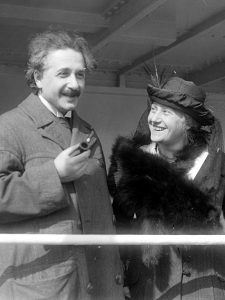 what could an average teacher teach him that he couldn’t learn on his own, and even begin to teach the teacher. I suppose that is the case with any genius, and it must have been a problem for many a teacher, not to mention to the child’s parents. Geniuses are a phenomena that most of us can only imagine, and maybe that is why it is felt that they should have a national day of their own. Often, the day is celebrated by a gathering of confirmed geniuses getting together to “show off” their skills. It is filled with competitions designed to exercise their minds in a group of their peers, which is definitely something they don’t get to do very often. I can’t think of a more fitting day for it to be celebrated than Albert Einstein’s birthday.
what could an average teacher teach him that he couldn’t learn on his own, and even begin to teach the teacher. I suppose that is the case with any genius, and it must have been a problem for many a teacher, not to mention to the child’s parents. Geniuses are a phenomena that most of us can only imagine, and maybe that is why it is felt that they should have a national day of their own. Often, the day is celebrated by a gathering of confirmed geniuses getting together to “show off” their skills. It is filled with competitions designed to exercise their minds in a group of their peers, which is definitely something they don’t get to do very often. I can’t think of a more fitting day for it to be celebrated than Albert Einstein’s birthday.
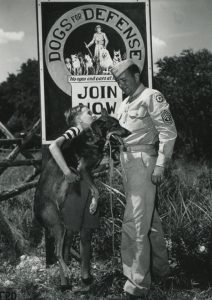 Most of us think of dogs as pets, and so they are, but they are so much more. Dogs know when their master is sick, lonely, or worried. Dogs ask little of their masters, and give so much back, but there is a group of dogs who are working dogs. In fact, we often see dogs in everyday life and think little of their presence, when in fact, their work is vital to those they work for. One of the most well known working dog groups is the K-9 Units. We think of these dogs as police dogs, and so they are, but originally, the K-9 Corps were founded in World War II. Of course, dogs were used long before that war, but not in the capacity of World War II.
Most of us think of dogs as pets, and so they are, but they are so much more. Dogs know when their master is sick, lonely, or worried. Dogs ask little of their masters, and give so much back, but there is a group of dogs who are working dogs. In fact, we often see dogs in everyday life and think little of their presence, when in fact, their work is vital to those they work for. One of the most well known working dog groups is the K-9 Units. We think of these dogs as police dogs, and so they are, but originally, the K-9 Corps were founded in World War II. Of course, dogs were used long before that war, but not in the capacity of World War II.
The Romans used dogs in battles, sending them in to attack the enemy. Native Americans used them as pack animals, as well as sentry animals. Even in the Middle Ages, dogs were sent into battle equipped with their own armor. Modern European societies had long established traditions of using dogs in war. But, I think that their use was probably made most famous 77 years ago, when in January of 1942, Dogs for Defense, Inc. was established as a national organization to help procure dogs for war training purposes. Although some dogs were acquired through purchase, it was largely through the dog owner population’s patriotic sentiments that most dogs were acquired for training. That really amazes me. I understand patriotism, and how people would volunteer in the service, but it seems strange to me to volunteer your dog. 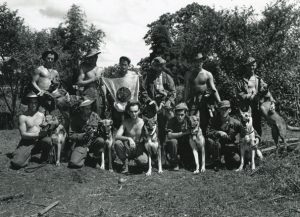 Nevertheless, they did. It was the job of Dogs For Defense not only to procure the dogs, but also to train them. Once trained, the dogs were to be given to the Quartermaster General, who then turned them over to the Plant Protection Branch and Inspection Division. Many thought the primary use of dogs would be as sentries for civilian war plants and quartermaster depot, but dogs have proven to be a much more.
Nevertheless, they did. It was the job of Dogs For Defense not only to procure the dogs, but also to train them. Once trained, the dogs were to be given to the Quartermaster General, who then turned them over to the Plant Protection Branch and Inspection Division. Many thought the primary use of dogs would be as sentries for civilian war plants and quartermaster depot, but dogs have proven to be a much more.
There are dogs that can sniff out drugs, gun powder…and the enemy. The DFD trained over 10,000 dogs. Most of the dogs were used at home for sentry duty, however, more than 1,800 dogs were sent into combat starting in 1942. The US Marine Corps sent over 1,000 dogs to be trained at their Camp Lejeune facility. Unfortunately, many commanders were unfamiliar, and maybe a little distrusting of the dogs, and didn’t know how to use them to their advantage. Seven Quartermaster Corps War Dog Platoons were sent to the European Theatre of Operations, but they did not have much success, probably due mostly to the lack of training with their handlers. In 1943, the QMC sent a detachment of six scout dogs and two messenger dogs to operate in the 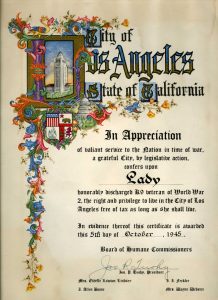 Pacific Theatre. This was a test of their value in combat conditions. The Japanese troops had deeply entrenched themselves on many islands in the Pacific theater of operations. Thousands were hiding in caves and in the dense jungles. They would lie very still, in wait for patrolling Marines and soldiers and then ambush them before the troops ever detected enemy forces. This is where the dogs proved their value. The first war dog platoons took to the Pacific island of New Britain. Here Marine war dogs attached to the Sixth Army first worked on sentry duty. Once a beachhead was established the dogs and handlers began conducting their patrols. They went on forty-eight patrols in fifty-three days. The dog patrols captured or killed 200 Japanese soldiers. This early success of war dog platoons set the standard for what could be expected, and what could not, from a K-9 detachment. I think that the more training given to both dogs and handlers, the better the results will be, as we have seen in K-9 police dogs in modern times.
Pacific Theatre. This was a test of their value in combat conditions. The Japanese troops had deeply entrenched themselves on many islands in the Pacific theater of operations. Thousands were hiding in caves and in the dense jungles. They would lie very still, in wait for patrolling Marines and soldiers and then ambush them before the troops ever detected enemy forces. This is where the dogs proved their value. The first war dog platoons took to the Pacific island of New Britain. Here Marine war dogs attached to the Sixth Army first worked on sentry duty. Once a beachhead was established the dogs and handlers began conducting their patrols. They went on forty-eight patrols in fifty-three days. The dog patrols captured or killed 200 Japanese soldiers. This early success of war dog platoons set the standard for what could be expected, and what could not, from a K-9 detachment. I think that the more training given to both dogs and handlers, the better the results will be, as we have seen in K-9 police dogs in modern times.
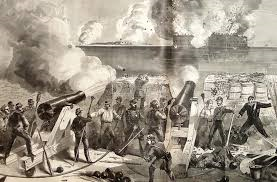 I think that anyone who has studied the Civil War, knows that it got started when the Confederates attacked Fort Sumter on April 12, 1861…officially anyway. Of course, the Civil War was all about slavery, and the North and South could not agree on the issue. As with all wars, there was some posturing before the war actually got started. Each side tries to scare the other into compliance, but sometimes that just doesn’t work out. The strange thing about the Civil War was that the “posturing stage” of the war ended up being a comedy of errors, when an inexperienced gunner accidently discharged his cannon into the fort on March 12, 1861. After the error, in which no one was hurt or killed, thankfully, the Confederates had to row over and apologize for the mistake. That strikes me as really funny, because everyone knew the war was coming, but just not when it would start.
I think that anyone who has studied the Civil War, knows that it got started when the Confederates attacked Fort Sumter on April 12, 1861…officially anyway. Of course, the Civil War was all about slavery, and the North and South could not agree on the issue. As with all wars, there was some posturing before the war actually got started. Each side tries to scare the other into compliance, but sometimes that just doesn’t work out. The strange thing about the Civil War was that the “posturing stage” of the war ended up being a comedy of errors, when an inexperienced gunner accidently discharged his cannon into the fort on March 12, 1861. After the error, in which no one was hurt or killed, thankfully, the Confederates had to row over and apologize for the mistake. That strikes me as really funny, because everyone knew the war was coming, but just not when it would start.
All that “practice” apparently didn’t help either, because when the war actually started, they fired over 3,000 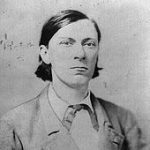 shells at the fort without injuring a single Union soldier. Nevertheless, the men at the fort were apparently intimidated, because they surrendered and a Confederate officer named Roger Pryor rowed out to negotiate the terms. As the discussion progressed, Pryor casually got up, poured himself a glass of whiskey. Probably not the best idea. He downed it in one gulp, before finding out that it was actually a bottle of medical iodine that happened to be nearby. Pryor’s “Three Stooges” moment ended with army doctors frantically pumping his stomach while nervous Union officers wondered how they were going to explain poisoning the negotiator. I can see it all now. The Union doctors were scrambling to save Pryor’s life, all the while thinking that the Confederate soldiers were going to accuse them of trying to murder him. Fortunately, Pryor survived, but the comedy of errors did not end there. In what would become one last screw-up, and to mark the surrender, the Union commander ordered his gunners to fire a salute. Once again, the “training” given was lacking or the soldiers were just careless. The gunners piled cartridges next to
shells at the fort without injuring a single Union soldier. Nevertheless, the men at the fort were apparently intimidated, because they surrendered and a Confederate officer named Roger Pryor rowed out to negotiate the terms. As the discussion progressed, Pryor casually got up, poured himself a glass of whiskey. Probably not the best idea. He downed it in one gulp, before finding out that it was actually a bottle of medical iodine that happened to be nearby. Pryor’s “Three Stooges” moment ended with army doctors frantically pumping his stomach while nervous Union officers wondered how they were going to explain poisoning the negotiator. I can see it all now. The Union doctors were scrambling to save Pryor’s life, all the while thinking that the Confederate soldiers were going to accuse them of trying to murder him. Fortunately, Pryor survived, but the comedy of errors did not end there. In what would become one last screw-up, and to mark the surrender, the Union commander ordered his gunners to fire a salute. Once again, the “training” given was lacking or the soldiers were just careless. The gunners piled cartridges next to 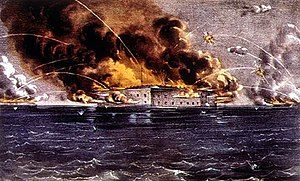 their cannons…in a high wind. The resulting explosion killed two of their own men, the only casualties of the siege.
their cannons…in a high wind. The resulting explosion killed two of their own men, the only casualties of the siege.
The war had at least one other comedy of errors, this time in Congress. In 1858, tensions between pro-slavery and anti-slavery factions were so heated that a huge brawl broke out between at least 30 Congressmen on the House floor. This was not just an argument, it was a brawl, and it only came to an end when Mississippi’s William Barksdale had his wig knocked off. Since Barksdale never admitted to wearing a wig, he quickly snatched it back up and put it on inside out, causing everyone to stop fighting and start laughing instead. Barksdale didn’t think it funny, but I do.

